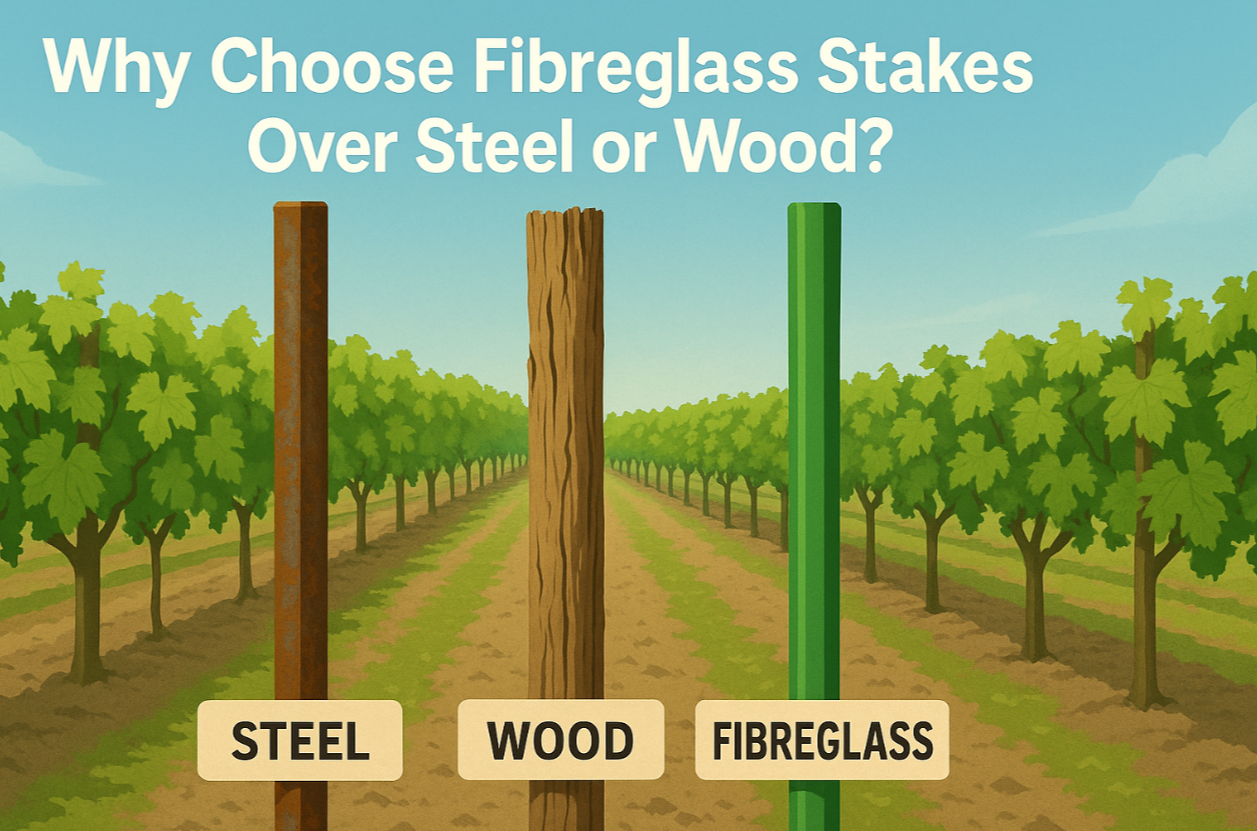Introduction
Selecting the right support system for vines, young trees, or civil-site utilities used to be a simple price comparison. Today, industrial buyers recognise that material choice affects safety records, maintenance budgets, and even regulatory compliance. Fibreglass stakes—pultruded bars made of glass-reinforced plastic—have emerged as the go-to upgrade for organisations that need long service life without rust, rot, or conductivity.
Unicomposite, an ISO-certified Chinese pultrusion manufacturer, supplies engineered FRP profiles to agriculture, power utilities, and OEMs worldwide. Drawing on field test data and customer feedback from these sectors, this guide explains when and why fibreglass beats steel or wood.

fibreglass stakes
Market Drivers for Switching to Fibreglass Stakes
Rising Material & Labor Costs
Commodity steel prices climbed 18 % between 2020 – 2024, and lumber futures spiked twice in the same period. Every replacement stake ordered is paid for with inflated dollars and scarce labour hours. Lightweight composite stakes cut installation time by about 25 % because crews handle bundles faster and skip surface-treatment steps.
Sustainability and Regulatory Pressures
The 2024 EU “Green Coatings” directive and the updated U.S. EPA VOC limits will add nearly $0.07 per linear foot to the cost of galvanized or painted steel posts over the next two years. Fibreglass needs no paint, helping buyers stay ahead of compliance curves and CSR scorecards.
Real-World Quote
“We snapped two wood stakes per row during every harvest. Since switching to fibreglass we haven’t logged a single breakage in three seasons,”
— Operations Manager, 1,500-acre almond orchard, California
Comparative Performance: Fibreglass vs Steel vs Wood
Strength-to-Weight Ratio & Load Capacity
Pultruded FRP posts deliver a tensile strength around 1,100 MPa—similar to mild steel—yet weigh 70 % less. Crews can carry 50-stake bundles without mechanical aids, reducing ergonomic injuries.
Corrosion, Rot, and UV Resistance
Steel must be galvanized or powder-coated; wood needs chemical treatment. Composite glass fibres embedded in a UV-stabilised resin shrug off coastal humidity and fertiliser salts. ASTM G154 accelerated-weathering tests show less than 5 % strength loss after 5,000 hours, versus 22 % for painted steel panels.
Electrical Insulation & Worker Safety
ASTM D2344 interlaminar shear tests confirm dielectric strength above 260 kV/cm. In power-utility settings, non-conductive stakes minimise step-potential hazards when crews drive earth rods or string temporary fencing.
Total Cost of Ownership (TCO) Analysis
Up-Front Price vs 10-Year Lifecycle Cost
Yes, a composite stake can cost 1.5× a raw pine stake. Yet lifecycle calculations tell a different story:
Replacement frequency: wood ~3 years, steel ~6 years, fibreglass 10 + years
Maintenance: coatings, insect treatments, corrosion checks = $0 for FRP
Handling: lighter loads cut forklift fuel and injury claims
Maintenance, Replacement Cycles, Downtime
Downtime during harvest or outage restoration is pure margin loss. By eliminating mid-season stake snapping, growers recoup about $420 per acre annually in avoided re-ties and fruit bruising.
Case Study – Vineyard Trellis Retrofit
A 20-acre Pacific-Northwest vineyard replaced 6,400 galvanized steel stakes with fibreglass stakes in 2021. Cap-ex rose 12 %, but operating costs dropped enough that the payback period was 2.8 years. Over five seasons the estate projects a 38 % total cost saving.
Customization & Engineering Flexibility
Tailored Dimensions, Colors, Surface Finishes
Pultrusion tooling allows diameters from 6 mm to 50 mm and lengths up to 10 m. Colour pigments are baked into the resin so branding never scratches off.
Integrating Drip-Irrigation Clips, Sensors, Branding
Milled notches or co-pultruded clip rails hold micro-tubes and soil-moisture probes flush to the stake, protecting them from harvest equipment.
How Unicomposite’s Pultrusion Lines Ensure Consistency
With six continuous lines and in-house R&D, Unicomposite controls glass mat lay-up, resin formulation, and post-cure inline sanding. That vertical integration lets engineers tweak flex-modulus or surface friction to suit your exact application—no minimum order surprises.
Procurement Best Practices & Specs Checklist
Key Standards, Tolerances, and Certifications
ISO 9001 factory QA audits
ASTM D638 tensile sampling every 5,000 m
RoHS / REACH resin compliance certificates for European importers
Shipping, Handling, and Storage Guidelines
Bundle stakes with polyester straps (not wire) to avoid print-through. Store flat out of direct sun until deployment; however, a 12-month yard exposure causes no measurable degradation.
Supplier Evaluation Questions for Bulk Buyers
Can you supply third-party mechanical test reports no older than 12 months?
What is the on-time delivery rate for the past four quarters?
Do you offer custom cut-to-length or secondary machining services in-house?
Conclusion
Fibreglass stakes deliver steel-like strength without corrosion, wood-like weight without rot, and unmatched electrical insulation—all of which translate into lower lifecycle cost and fewer safety headaches. Ready to validate the numbers on your next project? Contact our engineering team for a tailored ROI model or request a fast quote today.
Frequently Asked Questions
Q1. How long do fibreglass stakes really last in the field?
Lab data and field audits show 10–15 years before any mechanical derating—twice the span of galvanized steel in coastal climates.
Q2. Can I order stakes in custom colours or with my logo?
Yes. Pigments and surface veils are integrated during pultrusion, so colours and laser-etched branding arrive finished, saving post-processing costs.
Q3. Are composite stakes safe near high-voltage lines?
Their high dielectric strength prevents stray-current paths; nevertheless, always follow your site’s grounding plan.
Q4. What lead times should I expect for a 40-ft container?
Standard profiles ship in 2–3 weeks; custom tooling may extend the window to 6 weeks due to die fabrication.
Q5. How do freight costs compare with steel stakes?
Because fibreglass stakes weigh roughly 30 % of equivalent steel, a full container often ships at the weight minimum, trimming per-unit freight charges.
 info@unicomposite.com
info@unicomposite.com


























